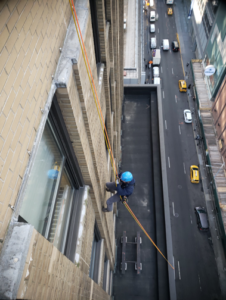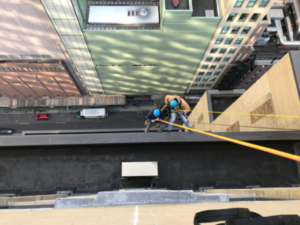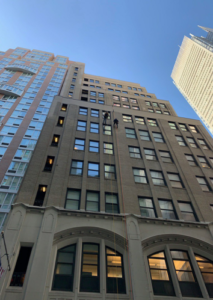
Rope access is a form of positioning that allows trained workers to access difficult-to-reach areas without the use of traditional methods, such as aerial lifts and scaffolding. The concept of rope access was implemented by the U.S. Navy as a way to gain access to perform work in inaccessible areas on large ships. The majority of work was done from a bosun’s chair, which was a platform generally made from heavy-duty canvas, mechanically attached to a rope; a worker could sit on the platform and ascend or descend in a controlled manner. During the 1980s, the use of the traditional bosun’s chair was integrated with climbing, caving techniques, and equipment to better assist workers to gain access to the hard-to-reach areas. While the fundamentals of ascending and descending down a rope remained the same, the new and more sophisticated equipment now allowed workers to safely position themselves in ways a conventional bosun’s chair could not.

Seeing rope access as a viable solution to repair and maintenance challenges at offshore rigs and wind turbines, the oil, gas, and renewable energy industries were some of the first to adopt this practice. During the late 1980s, the Industrial Rope Access Trade Association (IRATA) was formed in the U.K., and in the 1990s, the Society of Professional Rope Access Technicians (SPRAT) was formed in the U.S. Both of these associations were established to advance the safe use of ropes by educating, developing standards of practice, and administering certifications.  In cities around the world, rope access in accordance with either IRATA or SPRAT standards is becoming the most common way to safely gain access to perform inspections and general emergency repairs to the exteriors of buildings and structures.
In cities around the world, rope access in accordance with either IRATA or SPRAT standards is becoming the most common way to safely gain access to perform inspections and general emergency repairs to the exteriors of buildings and structures.
Rope access has proven to be a more efficient and cost-effective means of conducting non-destructive investigations of building exteriors than scaffolding and bridging systems. However, while this form of access might be a more cost-efficient mobilization method for inspection purposes, it does not provide adequate protection when performing exterior façade-work-related tasks. Additionally, the limited tools and materials at the disposal of workmen who are not necessarily in the most ergonomic position can hinder production. For example, an owner or property manager considering having a Façade Inspection and Safety Program (formerly Local Law 11) inspection of their building’s façades by means of rope access should understand that the installation of scaffolding and bridging might still be required if the inspection findings warrant corrective work.
